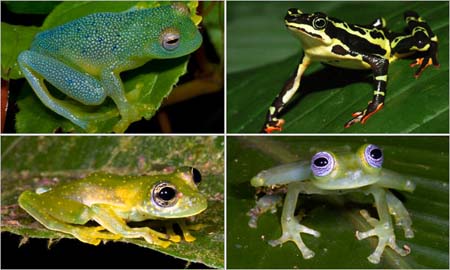The link between global warming and the disappearance of frogs is a challenge
The group of biologists has selected heterogeneous evidence, targeting many factors that cause widespread disappearance of frogs that change color.
The amphibians, of the Atelopus species - are actually toads, although the common name for them is frogs - once lived in huge numbers along streams on foggy slopes from Andes to Costa Rica. . After 20 years, they died out and were named by conservation organizations in the list of potentially endangered animals, mostly found only in the zoo.
A research team that is the author of the most cited article in Nature and who won the first prize in 2006 described global warming as the 'trigger' that led to the extinction of many species. The researchers said they found a clear link between unusually hot seasons and the disappearance of a number of frogs on mountain slopes.
The direct agent, scientists identified, as chytrid fungus, they attack amphibians in many places around the globe but are most powerful in certain climatic conditions. The authors, led by J.Alan Pounds of the Monteverde Forest Reserve in Costa Rica, said: 'Here we show that the recent major extinction has been linked to the outbreak of a source of disease originating from global warming. ' The study was included in the report last year by the multi-government panel.
Researchers have always questioned that connection. Last year, two responses in Nature raised the question in the 2006 paper. In the journal, Dr. Pounds and his team said that the new analysis results actually support their outlook. 'Global warming contributes to the crisis of amphibians,' but they evade and say it is the 'key factor'.
In the March 25 issue of PLoS Biologym, another group argued that the gradual death of discolored animals and some other amphibians reflected the spread of chytrid fungi. They suspect the results of the analysis of this disappearance of climate change. In an interview and an email exchange, Dr. Pounds and the lead author of the paper, Karen R. Lips of Sounthern Illinois University, argued about each person's explanation.

Three species of frogs were rescued from Panama: Cochranella granulose (upper left), Cochranella albomaculata (lower left), and Centrolene ilex (lower right). On the upper right is the colorful Atelopus from the Andes, Peru (Photo: Dante Fenolio)
Experts who have studied amphibians believe that no group has enough evidence to hold their ground and warn: this scientific debate should not distract from the fact that people are clear. obviously stirring up biology while only a little understanding of it.
'There are still many things we don't know yet!' David B.Wake, a biologist at the University of California, Berkeley, wrote in an e-mail after reading the article. The origin of that fungus and how they kill amphibians are still unknown, he said, and there are many mysteries why it grows in certain places and times without must go elsewhere, another time.
Dr. Pounds and Dr. Lips have all done important work, Dr. Wake added. 'I hope that this will not become a' contention contest 'because we still have a lot of things to know. about the decline of amphibians'
Ross A. Alford, a tropical biologist at James Cook University in Townsville, Australia, said the scientific debate, though important, can become confusing, especially when considering the risks. unclear muscle of global warming.
' Controversy over whether we can or can see the consequences,' he said, 'is like sitting in a house filled with gasoline, giving a burning match, and arguing about whether to see See the fire or not, or the match will turn itself off. '
- Global warming delays the next ice age
- Global warming can erase the Olympics since 2085
- Video: 135 years of global warming summed up for more than 30 seconds
- Scotland faces 'apocalypse' because of global warming
- The reason for the worsening winter is despite the global warming climate
- Cover the sun to block ... global warming
- Where will the sea level be highest due to global warming?
- Nature helps curb the global warming
- Global warming threatens the safety of flights
- Global warming has terrible consequences
- Two Vietnamese granaries will be submerged in the sea after 5 years?
- Sea water can rise by 6m in the future
 Is the magnetic North Pole shift dangerous to humanity?
Is the magnetic North Pole shift dangerous to humanity? Washington legalizes the recycling of human bodies into fertilizer
Washington legalizes the recycling of human bodies into fertilizer Lightning stone - the mysterious guest
Lightning stone - the mysterious guest Stunned by the mysterious sunset, strange appearance
Stunned by the mysterious sunset, strange appearance